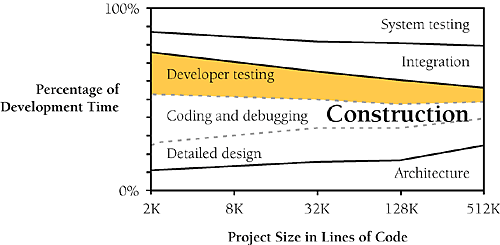Related Topics
The software-quality landscape: Chapter 20
Collaborative construction practices: Chapter 21
Debugging: Chapter 23
Integration: Chapter 29
Prerequisites to construction: Chapter 3
Testing is the most popular quality-improvement activity—a practice supported by a wealth of industrial and academic research and by commercial experience. Software is tested in numerous ways, some of which are typically performed by developers and some of which are more commonly performed by specialized test personnel:
Unit testing is the execution of a complete class, routine, or small program that has been written by a single programmer or team of programmers, which is tested in isolation from the more complete system.
Component testing is the execution of a class, package, small program, or other program element that involves the work of multiple programmers or programming teams, which is tested in isolation from the more complete system.
Integration testing is the combined execution of two or more classes, packages, components, or subsystems that have been created by multiple programmers or programming teams. This kind of testing typically starts as soon as there are two classes to test and continues until the entire system is complete.
Regression testing is the repetition of previously executed test cases for the purpose of finding defects in software that previously passed the same set of tests.
System testing is the execution of the software in its final configuration, including integration with other software and hardware systems. It tests for security, performance, resource loss, timing problems, and other issues that can't be tested at lower levels of integration.
In this chapter, "testing" refers to testing by the developer, which typically consists of unit tests, component tests, and integration tests but can sometimes include regression tests and system tests. Numerous additional kinds of testing are performed by specialized test personnel and are rarely performed by developers, including beta tests, customer-acceptance tests, performance tests, configuration tests, platform tests, stress tests, usability tests, and so on. These kinds of testing are not discussed further in this chapter.
Testing is usually broken into two broad categories: black-box testing and white-box (or glass-box) testing. "Black-box testing" refers to tests in which the tester cannot see the inner workings of the item being tested. This obviously does not apply when you test code that you have written! "White-box testing" refers to tests in which the tester is aware of the inner workings of the item being tested. This is the kind of testing that you as a developer use to test your own code. Both black-box and white-box testing have strengths and weaknesses; this chapter focuses on white-box testing because that's the kind of testing that developers perform.
Some programmers use the terms "testing" and "debugging" interchangeably, but careful programmers distinguish between the two activities. Testing is a means of detecting errors. Debugging is a means of diagnosing and correcting the root causes of errors that have already been detected. This chapter deals exclusively with error detection. Error correction is discussed in detail in Chapter 23.
The whole topic of testing is much larger than the subject of testing during construction. System testing, stress testing, black-box testing, and other topics for test specialists are discussed in the "Additional Resources" section at the end of the chapter.
Testing is an important part of any software-quality program, and in many cases it's the only part. This is unfortunate, because collaborative development practices in their various forms have been shown to find a higher percentage of errors than testing does, and they cost less than half as much per error found as testing does (Card 1987, Russell 1991, Kaplan 1995). Individual testing steps (unit test, component test, and integration test) typically find less than 50 percent of the errors present each. The combination of testing steps often finds less than 60 percent of the errors present (Jones 1998).
Cross-Reference
For details on reviews, see Chapter 21.
Programs do not acquire bugs as people acquire germs, by hanging around other buggy programs. Programmers must insert them.
If you were to list a set of software-development activities on "Sesame Street" and ask, "Which of these things is not like the others?" the answer would be "Testing." Testing is a hard activity for most developers to swallow for several reasons:
Testing's goal runs counter to the goals of other development activities. The goal is to find errors. A successful test is one that breaks the software. The goal of every other development activity is to prevent errors and keep the software from breaking.
Testing can never completely prove the absence of errors. If you have tested extensively and found thousands of errors, does it mean that you've found all the errors or that you have thousands more to find? An absence of errors could mean ineffective or incomplete test cases as easily as it could mean perfect software.
Testing by itself does not improve software quality. Test results are an indicator of quality, but in and of themselves they don't improve it. Trying to improve software quality by increasing the amount of testing is like trying to lose weight by weighing yourself more often. What you eat before you step onto the scale determines how much you will weigh, and the software-development techniques you use determine how many errors testing will find. If you want to lose weight, don't buy a new scale; change your diet. If you want to improve your software, don't just test more; develop better.
Testing requires you to assume that you'll find errors in your code. If you assume you won't, you probably won't, but only because you'll have set up a self-fulfilling prophecy. If you execute the program hoping that it won't have any errors, it will be too easy to overlook the errors you find. In a study that has become a classic, Glenford Myers had a group of experienced programmers test a program with 15 known defects. The average programmer found only 5 of the 15 errors. The best found only 9. The main source of undetected errors was that erroneous output was not examined carefully enough. The errors were visible, but the programmers didn't notice them (Myers 1978).
You must hope to find errors in your code. Such a hope might seem like an unnatural act, but you should hope that it's you who finds the errors and not someone else.
A key question is, How much time should be spent in developer testing on a typical project? A commonly cited figure for all testing is 50 percent of the time spent on the project, but that's misleading. First, that particular figure combines testing and debugging; testing alone takes less time. Second, that figure represents the amount of time that's typically spent rather than the time that should be spent. Third, the figure includes independent testing as well as developer testing.
As Figure 22-1 shows, depending on the project's size and complexity, developer testing should probably take 8 to 25 percent of the total project time. This is consistent with much of the data that has been reported.
Figure 22-1. As the size of the project increases, developer testing consumes a smaller percentage of the total development time. The effects of program size are described in more detail in Chapter 27.
A second question is, What do you do with the results of developer testing? Most immediately, you can use the results to assess the reliability of the product under development. Even if you never correct the defects that testing finds, testing describes how reliable the software is. Another use for the results is that they can and usually do guide corrections to the software. Finally, over time, the record of defects found through testing helps reveal the kinds of errors that are most common. You can use this information to select appropriate training classes, direct future technical review activities, and design future test cases.
The big, wide world of testing sometimes ignores the subject of this chapter: "white-box" or "glass-box" testing. You generally want to design a class to be a black box—a user of the class won't have to look past the interface to know what the class does. In testing the class, however, it's advantageous to treat it as a glass box, to look at the internal source code of the class as well as its inputs and outputs. If you know what's inside the box, you can test the class more thoroughly. Of course, you also have the same blind spots in testing the class that you had in writing it, and so black-box testing has advantages too.
During construction, you generally write a routine or class, check it mentally, and then review it or test it. Regardless of your integration or system-testing strategy, you should test each unit thoroughly before you combine it with any others. If you're writing several routines, you should test them one at a time. Routines aren't really any easier to test individually, but they're much easier to debug. If you throw several untested routines together at once and find an error, any of the several routines might be guilty. If you add one routine at a time to a collection of previously tested routines, you know that any new errors are the result of the new routine or of interactions with the new routine. The debugging job is easier.
Collaborative construction practices have many strengths to offer that testing can't match. But part of the problem with testing is that testing often isn't performed as well as it could be. A developer can perform hundreds of tests and still achieve only partial code coverage. A feeling of good test coverage doesn't mean that actual test coverage is adequate. An understanding of basic test concepts can support better testing and raise testing's effectiveness.



